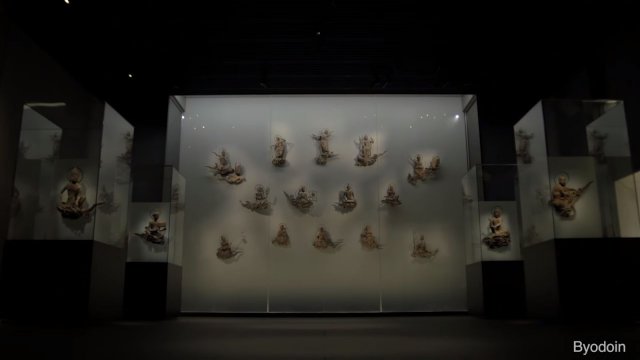
Dec 25, 2025
- Products & Solutions
- Stories
- Technology
- AI & Robotics
- R&D
- Business Solutions

The original expressions and exquisite colors and intricate details of the esteemed national treasures and cultural assets are beautifully accentuated by lighting.
Panasonic's LED lighting has made this possible at the Byodoin Museum Hoshokan (Uji City, Kyoto Prefecture).
Since being constructed nearly 1000 years ago, Byodoin has continued to preserve ancient Kyoto's cultural assets such as architecture, numerous Buddha statues, paintings and other works of art. It is also a registered World Heritage site. Mr. Monsho Kamii, Byodoin's Chief Priest described the lighting created as follows: "At the Byodoin, you will find the Phoenix Hall, a very elegant, majestic building from the Heian Period. Majority of the Buddha statues, paintings, fine arts and crafts are housed in the museum located in the Phoenix Hall. This light has brought to life a new world, but what we wished for and what was most important to us was that it brings out the true nature of our assets."
The planning and design of the lighting was supervised by Mr. Shisei Kinoshita, the General Manager of Design, Curation Planning Division of the Tokyo National Museum. And Ryuji Hotta, the Lighting Designer of the Solution Lighting Design Group, Eco Solutions Company, Panasonic Corporation said, "We can adjust the color temperature and control the distribution of light to make the objects look even more appealing. So I knew that with LEDs we would be able to highlight the unique features of each piece. And when it comes to protecting the objects, LEDs emit hardly any UV and infrared light, as such, it causes hardly any damage."
Following countless adjustments, approximately 400 units(*1) of Panasonic's state-of-the-art LED lighting solutions were delivered to the museum in November, 2015. The new solutions cut down power consumption by 70%(*2) in comparison to conventional lighting. And also in comparison to conventional lighting, the new solutions offered around 82%(*3) savings on annual running costs (electricity bill and the cost of exchanging lamps), realizing both energy and cost savings.
The ceiling of the long, straight entrance becomes higher in 3 stages, and in the end, the space lets in natural light from the outside. The LEDs installed here have a very high color temperature, and they have been designed in a way to resemble sunlight pouring in.
The lighting brings out the unique beauty of the blue-green patina color of the Bonsho. The bell looks as though it is floating mid-air, and the light makes things such as the lions and celestial beings stereoscopic rather than flat.
The light was designed in a way to ensure that only the phoenix would stand out in the darkness of the exhibition hall and to avoid having multiple shadows to make the phoenix appear more majestic and powerful.
"The statues seems as though they have appeared from the skies, the clouds, and each seems to have a clear, strong resolve. They created lighting that features them individually, but also as a whole. It is very important that the lights for each statue do not interfere with one another," said the Chief Priest Kamii. Lights positioned underneath make the statues appear as though they are floating in mid air.
In the temporary exhibition space, shooting spotlights were used. Since various different objects will be displayed in this space, the direction, scope, and brightness of lighting may be optimally adjusted using smartphones and tablets for new exhibits. This solution has also enhanced safety by eliminating a need to work in high places.
"Lighting plays a supportive role so many visitors may not even notice it. Even so, it would be ideal if people will feel that the ambience of the museum was nice and our lighting contributed to this feeling in some way behind the scenes," said Hotta.
According to Chief Priest Kamii, " In Buddhist way of thinking, and this applies to Buddhist art and architecture as well, but things are never "complete." That is why we may leave one tile off the roof to express that it is always one step away from completion. This is also true for our new lighting. People at Panasonic are still experimenting and exploring other possibilities. This is not finished yet. I think the next time you come you will see a different expression created by lighting. We hope to continue to work together with Panasonic to always create new experiences."
*1: Some of the construction work will take place in July 2016.
*2: Economic comparison criteria: Calculated based on replacing existent lighting with the newly delivered LED solutions; light turned on for 8 hours a day, 365 days a year.
*3: The running costs with conventional lighting when lights are turned on for 8 hours a day, for 1 year comes out to be 2.02 million yen annually. With the newly delivered LEDs, the running costs are significantly lower at 370,000 yen.
The content in this website is accurate at the time of publication but may be subject to change without notice.
Please note therefore that these documents may not always contain the most up-to-date information.
Please note that German, Spanish and Chinese versions are machine translations, so the quality and accuracy may vary.